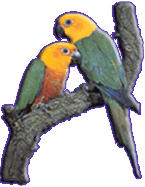They mate once a year. Female hatches 3-5 white eggs in lair and broods for 30 days. Eggs are 22 x 28 mm in size. After hatching from the egg, the young stay in the nest for eight weeks and after leaving the nest they stay with the parents for another 45 days. During this period, colors of feathers in young birds are rather undefined until they are two years old when they get their real appearance and become sexually mature.
Diet consists of seedish mix of sunflower, millet, oat, sorghum, hemp, non-fried shelled peanuts and bar-millet. Choice of fruits and vegetables is the same as in Jandaya diet, and vitamins and minerals are obligatory (for information on types of vitamins and minerals as well as dosage consult the breeder).
Personally, I am delighted with this bird, with its variety of colors and personality so if you are looking for a pet this is my favorite!
|
|

